engine MITSUBISHI COLT 2008 (in English) Owner's Guide
[x] Cancel search | Manufacturer: MITSUBISHI, Model Year: 2008, Model line: COLT, Model: MITSUBISHI COLT 2008Pages: 450, PDF Size: 14.57 MB
Page 157 of 450
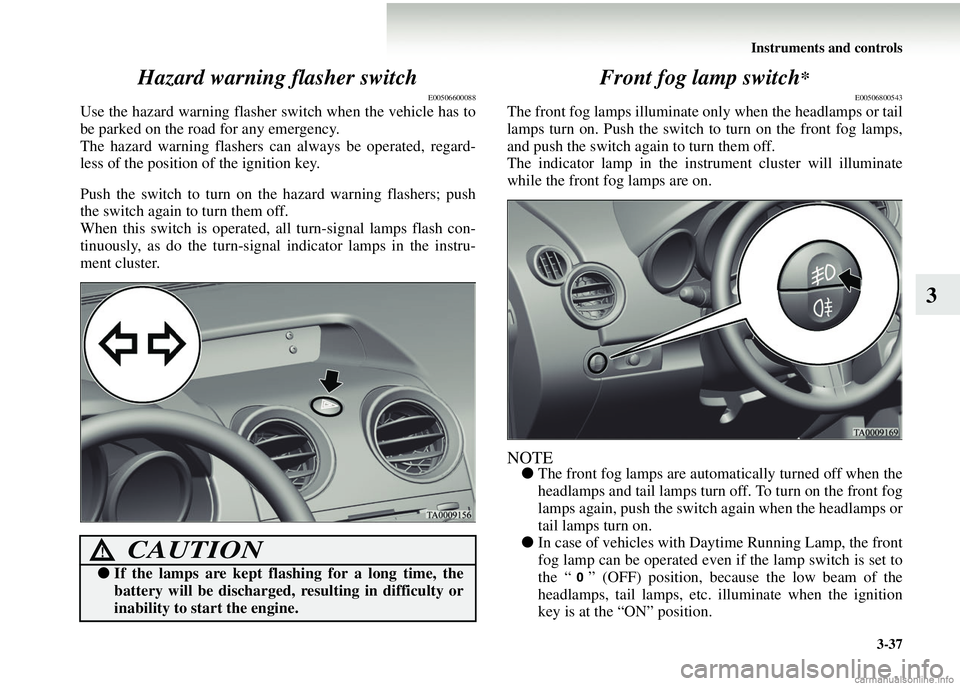
Instruments and controls3-37
3
Hazard warning flasher switch
E00506600088
Use the hazard warning flasher switch when the vehicle has to
be parked on the road for any emergency.
The hazard warning flashers can always be operated, regard-
less of the position of the ignition key.
Push the switch to turn on the hazard warning flashers; push
the switch again to turn them off.
When this switch is operated, all turn-signal lamps flash con-
tinuously, as do the turn-signal indicator lamps in the instru-
ment cluster.
Front fog lamp switch*
E00506800543
The front fog lamps illuminate only when the headlamps or tail
lamps turn on. Push the switch to turn on the front fog lamps,
and push the switch again to turn them off.
The indicator lamp in the instrument cluster will illuminate
while the front fog lamps are on.
NOTE●
The front fog lamps are automa tically turned off when the
headlamps and tail lamps turn off. To turn on the front fog
lamps again, push the switch again when the headlamps or
tail lamps turn on.
● In case of vehicles with Daytime Running Lamp, the front
fog lamp can be operated even if the lamp switch is set to
the “ ” (OFF) position, becau se the low beam of the
headlamps, tail lamps, etc. illuminate when the ignition
key is at the “ON” position.
CAUTION!
● If the lamps are kept flashing for a long time, the
battery will be discharged, resulting in difficulty or
inability to start the engine.
Page 166 of 450
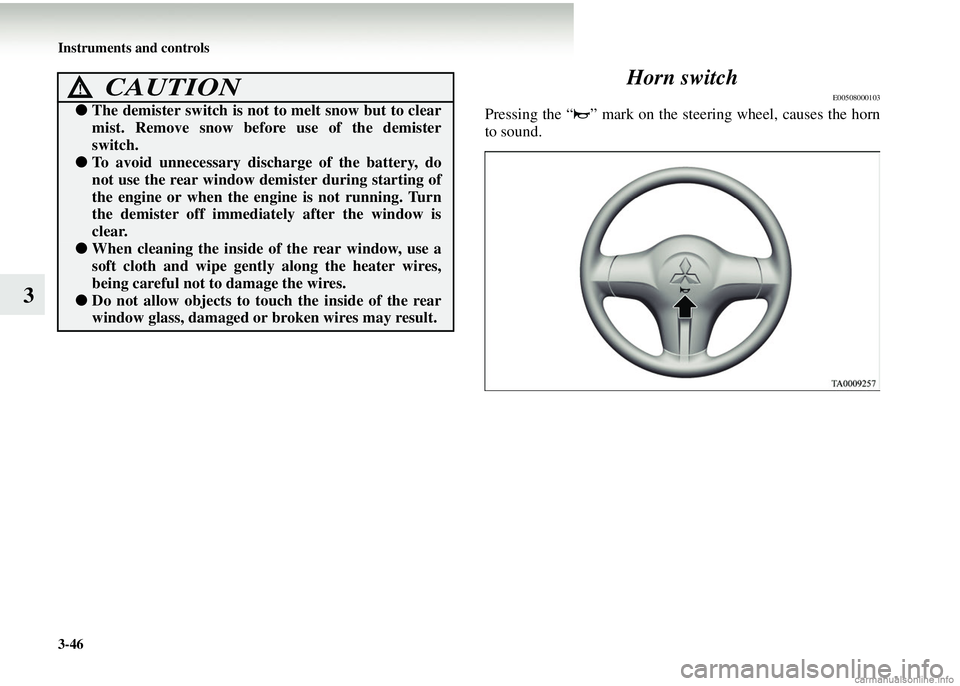
3-46 Instruments and controls
3Horn switch
E00508000103
Pressing the “ ” mark on the steering wheel, causes the horn
to sound.
CAUTION!
●
The demister switch is not to melt snow but to clear
mist. Remove snow before use of the demister
switch.
●To avoid unnecessary disc harge of the battery, do
not use the rear window de mister during starting of
the engine or when the en gine is not running. Turn
the demister off immediat ely after the window is
clear.
● When cleaning the inside of the rear window, use a
soft cloth and wipe gently along the heater wires,
being careful not to damage the wires.
●Do not allow objects to touch the inside of the rear
window glass, damaged or broken wires may result.
Page 168 of 450
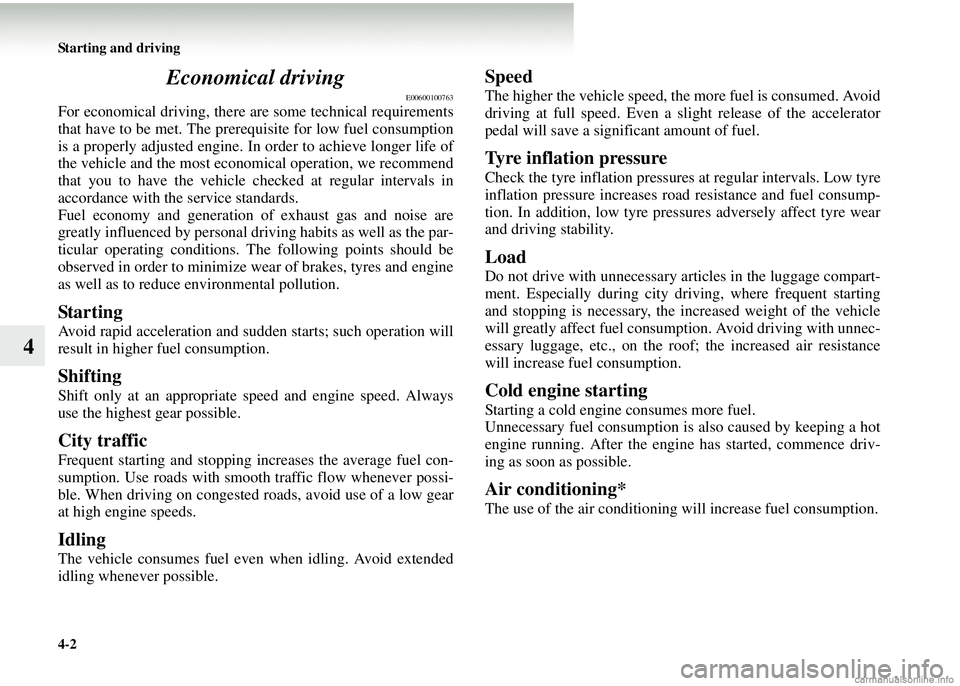
4-2 Starting and driving
4Economical driving
E00600100763
For economical driving, there ar
e some technical requirements
that have to be met. The prerequisite for low fuel consumption
is a properly adjusted engine. In order to achieve longer life of
the vehicle and the most economical operation, we recommend
that you to have the vehicle checked at regular intervals in
accordance with the service standards.
Fuel economy and generation of exhaust gas and noise are
greatly influenced by personal driving habits as well as the par-
ticular operating conditions. The following points should be
observed in order to minimize w ear of brakes, tyres and engine
as well as to reduce environmental pollution.
Starting
Avoid rapid acceleration and sudden starts; such operation will
result in higher fuel consumption.
Shifting
Shift only at an appropriate speed and engine speed. Always
use the highest gear possible.
City traffic
Frequent starting and stopping increases the average fuel con-
sumption. Use roads with smooth traffic flow whenever possi-
ble. When driving on congested roads, avoid use of a low gear
at high engine speeds.
Idling
The vehicle consumes fuel even when idling. Avoid extended
idling whenever possible.
Speed
The higher the vehicle speed, the more fuel is consumed. Avoid
driving at full speed. Even a slight release of the accelerator
pedal will save a significant amount of fuel.
Tyre inflation pressure
Check the tyre inflation pressure s at regular intervals. Low tyre
inflation pressure increases ro ad resistance and fuel consump-
tion. In addition, low tyre pres sures adversely affect tyre wear
and driving stability.
Load
Do not drive with unnecessary articles in the luggage compart-
ment. Especially during city dr iving, where frequent starting
and stopping is necessary, the increased weight of the vehicle
will greatly affect fuel consum ption. Avoid driving with unnec-
essary luggage, etc., on the ro of; the increased air resistance
will increase fuel consumption.
Cold engine starting
Starting a cold engine consumes more fuel.
Unnecessary fuel consumption is also caused by keeping a hot
engine running. After the engine has started, commence driv-
ing as soon as possible.
Air conditioning*
The use of the air conditioning will increase fuel consumption.
Page 171 of 450
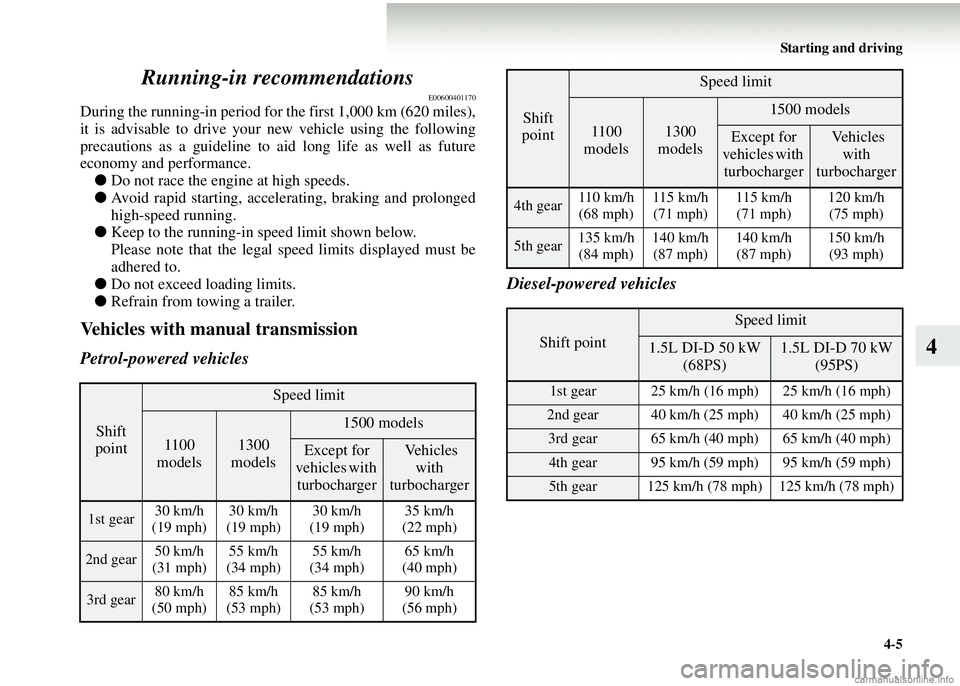
Starting and driving4-5
4
Running-in recommendations
E00600401170
During the running-in period for the first 1,000 km (620 miles),
it is advisable to drive your new vehicle using the following
precautions as a guideline to aid
long life as well as future
economy and performance. ● Do not race the engine at high speeds.
● Avoid rapid starting, accelerating, braking and prolonged
high-speed running.
● Keep to the running-in speed limit shown below.
Please note that the legal speed limits displayed must be
adhered to.
● Do not exceed loading limits.
● Refrain from towing a trailer.
Vehicles with manual transmission
Petrol-powered vehicles Diesel-powered vehicles
Shift
point
Speed limit
1100
models1300
models
1500 models
Except for
vehicles with turbocharger Vehicles
with
turbocharger
1st gear 30 km/h
(19 mph) 30 km/h
(19 mph) 30 km/h
(19 mph) 35 km/h
(22 mph)
2nd gear 50 km/h
(31 mph) 55 km/h
(34 mph) 55 km/h
(34 mph) 65 km/h
(40 mph)
3rd gear 80 km/h
(50 mph) 85 km/h
(53 mph) 85 km/h
(53 mph) 90 km/h
(56 mph)
4th gear 110 km/h
(68 mph) 115 km/h
(71 mph) 115 km/h
(71 mph) 120 km/h
(75 mph)
5th gear 135 km/h
(84 mph) 140 km/h
(87 mph) 140 km/h
(87 mph) 150 km/h
(93 mph)
Shift point
Speed limit
1.5L DI-D 50 kW (68PS)1.5L DI-D 70 kW (95PS)
1st gear 25 km/h (16 mph) 25 km/h (16 mph)
2nd gear 40 km/h (25 mph) 40 km/h (25 mph)
3rd gear 65 km/h (40 mph) 65 km/h (40 mph)
4th gear 95 km/h (59 mph) 95 km/h (59 mph)
5th gear 125 km/h (78 mph) 125 km/h (78 mph)
Shift
point
Speed limit
1100
models1300
models
1500 models
Except for
vehicles with turbocharger Vehicles
with
turbocharger
Page 174 of 450
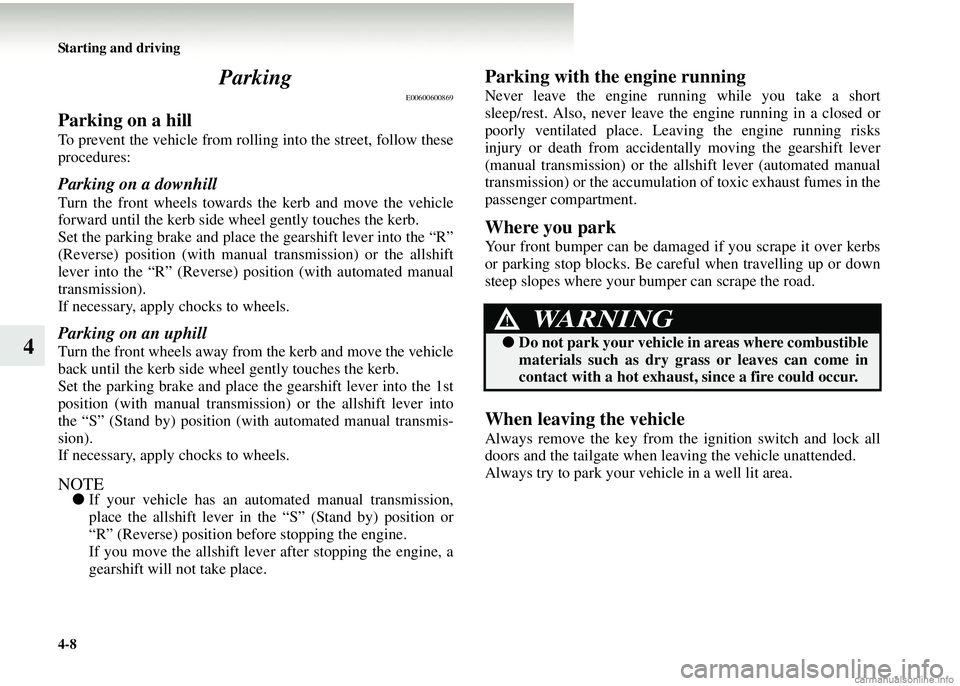
4-8 Starting and driving
4Parking
E00600600869
Parking on a hill
To prevent the vehicle from rolling into the street, follow these
procedures:
Parking on a downhill
Turn the front wheels towards
the kerb and move the vehicle
forward until the kerb side wheel gently touches the kerb.
Set the parking brake and place the gearshift lever into the “R”
(Reverse) position (with manual transmission) or the allshift
lever into the “R” (Reverse) position (with automated manual
transmission).
If necessary, apply chocks to wheels.
Parking on an uphill
Turn the front wheels away from the kerb and move the vehicle
back until the kerb side wheel gently touches the kerb.
Set the parking brake and place th e gearshift lever into the 1st
position (with manual transmission) or the allshift lever into
the “S” (Stand by) position (with automated manual transmis-
sion).
If necessary, apply chocks to wheels.
NOTE● If your vehicle has an automated manual transmission,
place the allshift lever in the “S” (Stand by) position or
“R” (Reverse) position before stopping the engine.
If you move the allshift lever after stopping the engine, a
gearshift will not take place.
Parking with the engine running
Never leave the engine running while you take a short
sleep/rest. Also, never leave the engine running in a closed or
poorly ventilated place. Leaving the engine running risks
injury or death from accidental ly moving the gearshift lever
(manual transmission) or the allshift lever (automated manual
transmission) or the accumulation of toxic exhaust fumes in the
passenger compartment.
Where you park
Your front bumper can be damaged if you scrape it over kerbs
or parking stop blocks. Be careful when travelling up or down
steep slopes where your bumper can scrape the road.
When leaving the vehicle
Always remove the key from the ignition switch and lock all
doors and the tailgate when leaving the vehicle unattended.
Always try to park your vehicle in a well lit area.
WARNING!
● Do not park your vehicle in areas where combustible
materials such as dry grass or leaves can come in
contact with a hot exhaust, since a fire could occur.
Page 180 of 450
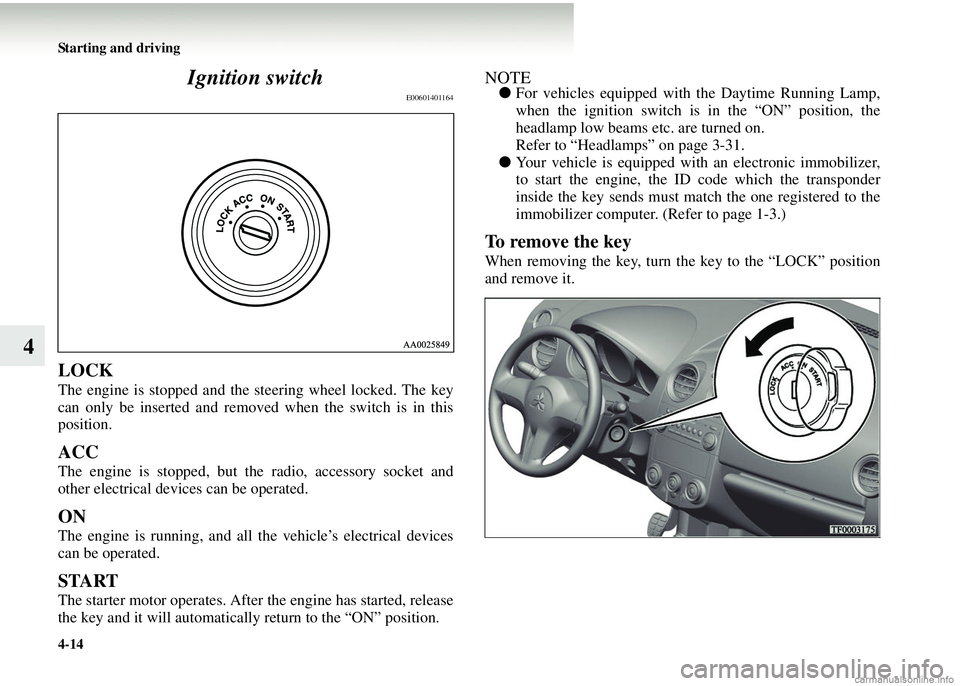
4-14 Starting and driving
4Ignition switch
E00601401164
LOCK
The engine is stopped and the
steering wheel locked. The key
can only be inserted and removed when the switch is in this
position.
ACC
The engine is stopped, but th e radio, accessory socket and
other electrical devices can be operated.
ON
The engine is running, and all the vehicle’s electrical devices
can be operated.
START
The starter motor operates. After the engine has started, release
the key and it will automatically return to the “ON” position.
NOTE● For vehicles equipped with the Daytime Running Lamp,
when the ignition switch is in the “ON” position, the
headlamp low beams etc. are turned on.
Refer to “Headlamps” on page 3-31.
● Your vehicle is equipped with an electronic immobilizer,
to start the engine, the ID code which the transponder
inside the key sends must match the one registered to the
immobilizer computer. (Refer to page 1-3.)
To remove the key
When removing the key, turn the key to the “LOCK” position
and remove it.
Page 181 of 450
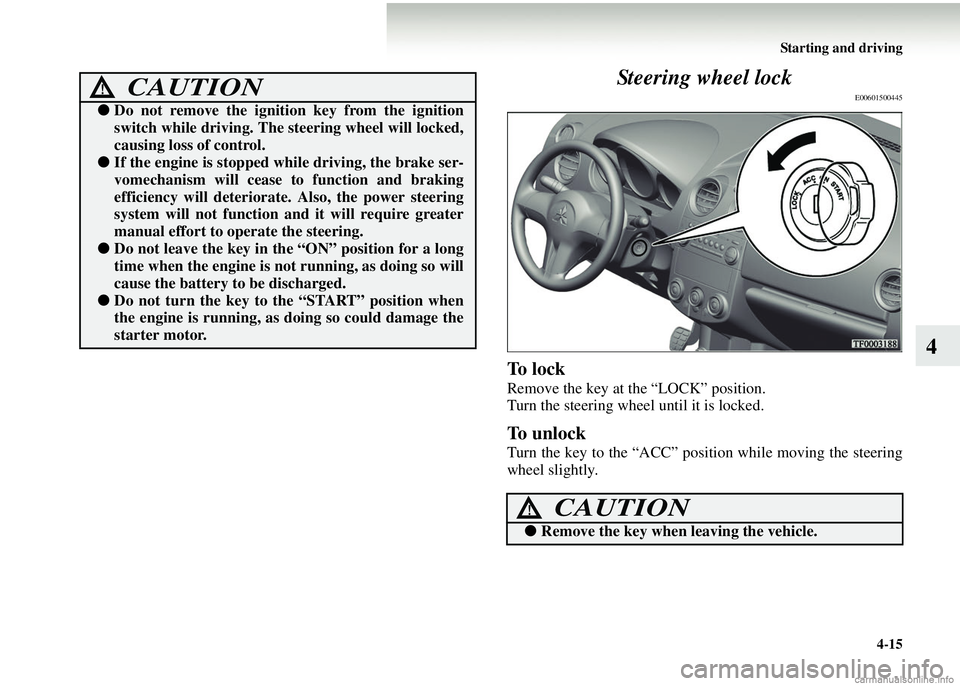
Starting and driving4-15
4
Steering wheel lock
E00601500445
To l o c k
Remove the key at the “LOCK” position.
Turn the steering wheel until it is locked.
To unlock
Turn the key to the “ACC” position while moving the steering
wheel slightly.
CAUTION!
●
Do not remove the ignition key from the ignition
switch while driving. The steering wheel will locked,
causing loss of control.
●If the engine is stopped while driving, the brake ser-
vomechanism will cease to function and braking
efficiency will deteriorat e. Also, the power steering
system will not function and it will require greater
manual effort to operate the steering.
● Do not leave the key in the “ON” position for a long
time when the engine is no t running, as doing so will
cause the battery to be discharged.
●Do not turn the key to the “START” position when
the engine is running, as doing so could damage the
starter motor.
CAUTION!
●Remove the key when leaving the vehicle.
Page 182 of 450
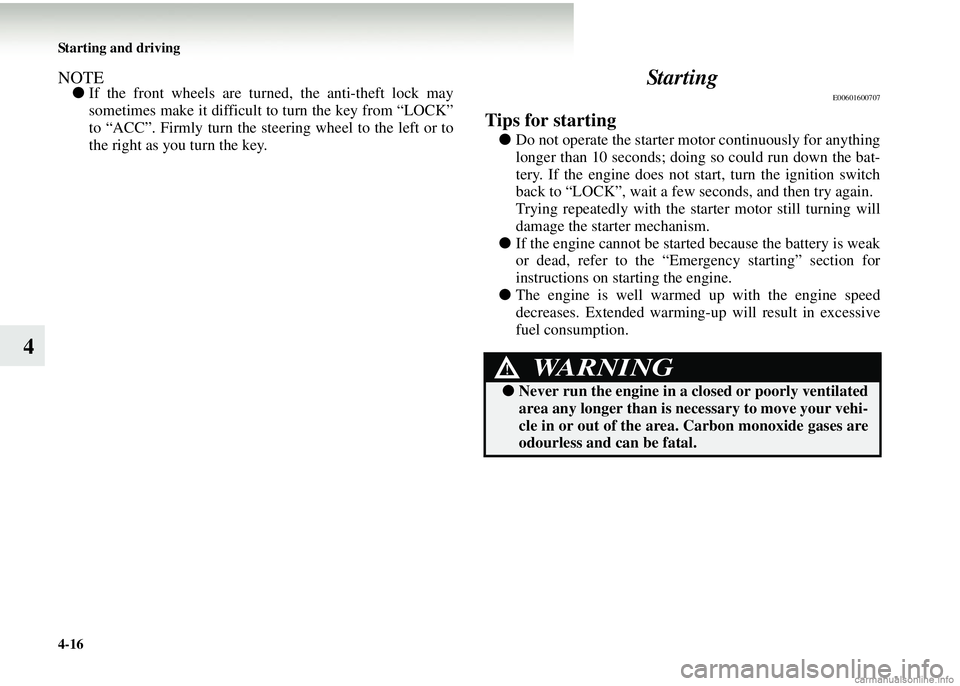
4-16 Starting and driving
4
NOTE●If the front wheels are turned , the anti-theft lock may
sometimes make it difficult to turn the key from “LOCK”
to “ACC”. Firmly turn the steer ing wheel to the left or to
the right as you turn the key.Starting
E00601600707
Tips for starting
● Do not operate the starter motor continuously for anything
longer than 10 seconds; doing so could run down the bat-
tery. If the engine does not start, turn the ignition switch
back to “LOCK”, wait a few seconds, and then try again.
Trying repeatedly with the starter motor still turning will
damage the starter mechanism.
● If the engine cannot be starte d because the battery is weak
or dead, refer to the “Emergency starting” section for
instructions on starting the engine.
● The engine is well warmed up with the engine speed
decreases. Extended warming-up will result in excessive
fuel consumption.
WARNING!
● Never run the engine in a cl osed or poorly ventilated
area any longer than is necessary to move your vehi-
cle in or out of the area. Carbon monoxide gases are
odourless and can be fatal.
Page 183 of 450
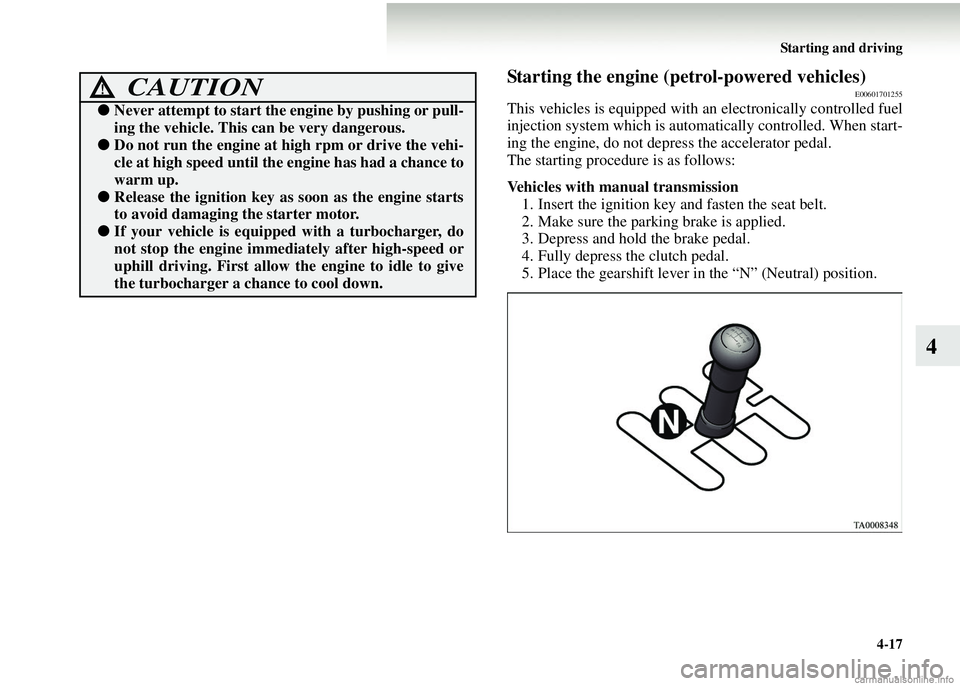
Starting and driving4-17
4
Starting the engine (petrol-powered vehicles)E00601701255
This vehicles is equipped with an electronically controlled fuel
injection system which is automa tically controlled. When start-
ing the engine, do not de press the accelerator pedal.
The starting procedure is as follows:
Vehicles with manual transmission 1. Insert the ignition key and fasten the seat belt.
2. Make sure the parking brake is applied.
3. Depress and hold the brake pedal.
4. Fully depress the clutch pedal.
5. Place the gearshift lever in the “N” (Neutral) position.
CAUTION!
●Never attempt to start the engine by pushing or pull-
ing the vehicle. This can be very dangerous.
●Do not run the engine at high rpm or drive the vehi-
cle at high speed until th e engine has had a chance to
warm up.
● Release the ignition key as soon as the engine starts
to avoid damaging the starter motor.
●If your vehicle is equipped with a turbocharger, do
not stop the engine immedi ately after high-speed or
uphill driving. First allow the engine to idle to give
the turbocharger a chance to cool down.
Page 184 of 450
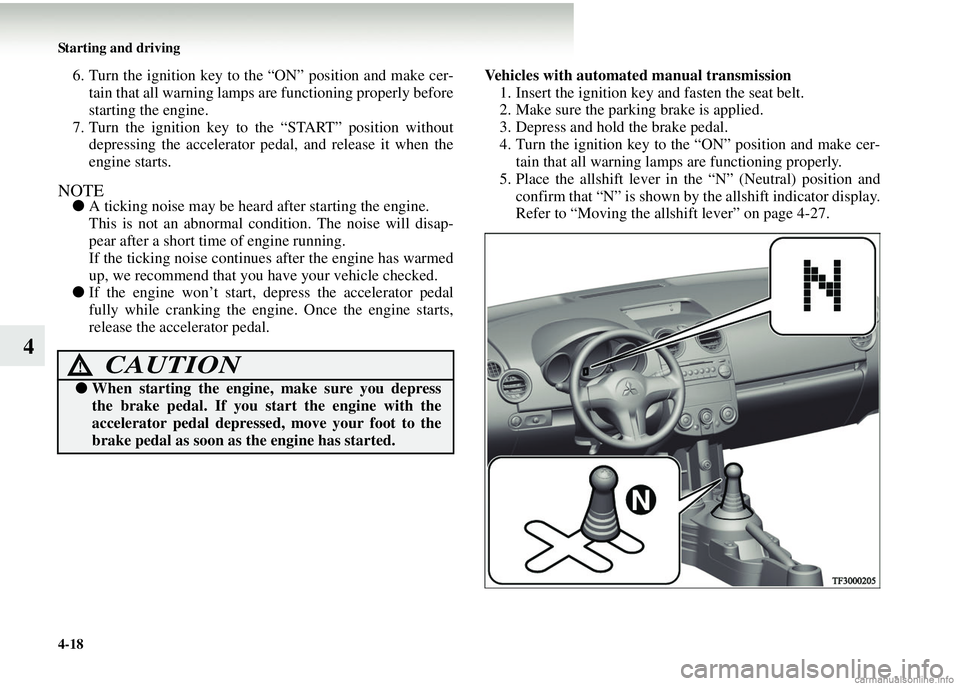
4-18 Starting and driving
4
6. Turn the ignition key to the “ON” position and make cer-tain that all warning lamps are functioning properly before
starting the engine.
7. Turn the ignition key to the “START” position without depressing the accelerator pedal, and release it when the
engine starts.
NOTE● A ticking noise may be heard after starting the engine.
This is not an abnormal condition. The noise will disap-
pear after a short time of engine running.
If the ticking noise continues after the engine has warmed
up, we recommend that you have your vehicle checked.
● If the engine won’t start, depress the accelerator pedal
fully while cranking the engi ne. Once the engine starts,
release the accelerator pedal. Vehicles with automated manual transmission
1. Insert the ignition key and fasten the seat belt.
2. Make sure the parking brake is applied.
3. Depress and hold the brake pedal.
4. Turn the ignition key to the “ON” position and make cer- tain that all warning lamps are functioning properly.
5. Place the allshift lever in the “N” (Neutral) position and confirm that “N” is shown by the allshift indicator display.
Refer to “Moving the allshift lever” on page 4-27.
CAUTION!
● When starting the engine, make sure you depress
the brake pedal. If you st art the engine with the
accelerator pedal depressed, move your foot to the
brake pedal as soon as the engine has started.